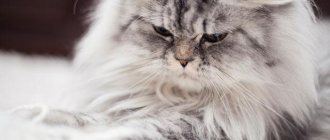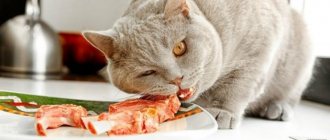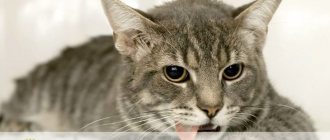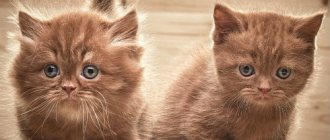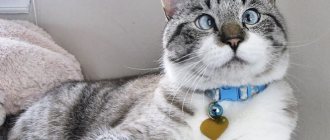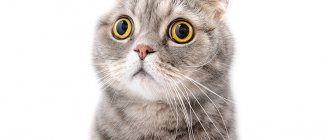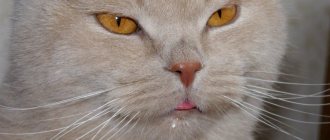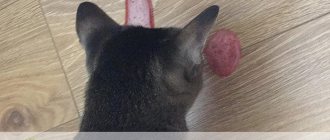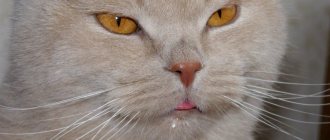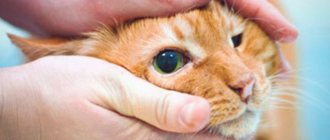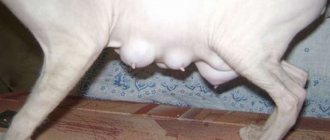Cat's vomit is yellow
Almost all owners panic when their cats vomit yellow liquid. But you need to pull yourself together and observe how often this happens.
If yellow vomit occurs once and there are no other symptoms, a visit to the veterinarian is not required. However, if a cat vomits yellow liquid for several hours or days, he needs to be seen by a specialist immediately - this indicates the accumulation of too much bile in the stomach.
In a kitten, vomiting yellow liquid usually occurs in the presence of congenital pathologies of the digestive organs. This condition requires immediate medical attention. After all, the smaller the kitten, the higher the likelihood of its death due to dehydration. Babies older than 3 months have a higher survival rate in this situation.
Important! Bile can eat away at the stomach lining. Its prolonged accumulation in the stomach leads to the development of inflammation of the digestive organs and even the appearance of ulcers.
The mechanism of the gag reflex
Usually, owners believe that the cat vomited due to coughing. In fact, it is a symptom of vomiting, not a cause. The attack usually proceeds as follows:
- The cat appears to have increased salivation. She worries, constantly licks herself and swallows the saliva that forms.
- Then a cough begins, the animal breathes frequently and deeply, and stretches its head forward.
- The area of the pharynx and abdomen contracts, first fruitless vomiting appears, and then with the contents.
Important! For cats, vomiting every 3-4 days is normal.
Most often, cats vomit when they eat too quickly or eat too much. This often happens when feeding with low-quality industrial feed or with a mixed diet. Vomiting may also appear in the morning if the cat fell asleep hungry the day before.
If vomiting occurs from overeating, you just need to not let your pet eat or drink for 8 hours, and instead of water, offer to lick an ice cube. If a cat systematically vomits due to an incorrectly formulated diet, it needs to be reconsidered.
All long-haired cats also suffer from nausea and vomiting. When licked, the fur enters the stomach, where it gradually rolls into lumps, which cause irritation of the gastrointestinal tract. This is why burping fur should not be a concern. If there is blood, foam or mucus in the vomit, you should immediately contact the clinic.
What to do when your cat vomits yellow liquid?
- slime;
- foam;
- leftover food.
Overeating
This reaction occurs when there is an abundance of fatty foods in the diet. This is especially evident with a mixed type of nutrition, where industrial feed and natural food are used. In this case, the cat needs a special diet.
Long-haired cats actively lick themselves and the hair gets into the stomach. Over time, it clumps into lumps, which cause gastrointestinal irritation. In case of blockage, vomit contains mucus, blood, and foam. This condition requires urgent surgery.
The most dangerous situation is when the cat vomits bile, he does not eat anything and only drinks water. Symptoms are typical for injuries to internal organs, ingestion of a foreign body. Fish or chicken bones injure and irritate the gastric mucosa. In some cases, surgery is required.
If a cat has yellow vomiting with foam, this may be a sign of infectious diseases - panleukopenia or plague. The vomit will not contain impurities such as hair or food debris.
The gag reflex protects the body from poisoning by toxic substances. Infection with a large number of worms contributes to the development of intoxication. Parasites are a serious irritant and this contributes to the appearance of vomiting.
If this happens during pregnancy, then the cat’s gallbladder pathologies have worsened.
Causes of yellow vomit in cats
The correct diagnosis largely depends on the reasons why the cat is vomiting yellow liquid. If the owner remembers when the cat vomited for the first time, and how often it happened in the future, this will help in diagnosis.
Reasons why a cat vomits bile:
- Foreign body in the stomach. Often, while playing, kittens accidentally swallow small objects. If the item eaten is very small, it will pass out with the feces without any problems. If it is quite large in size, the cat’s body will begin to actively produce bile to speed up the digestive process. As a result, the cat will begin to feel nauseated, and along with the vomit, it will regurgitate excess bile.
Important! Large objects eaten by a cat cannot be removed by its intestines, so the pet may well experience a blockage in the stomach or esophagus. If you accidentally swallow various objects, it is better to play it safe and take your cat to see a veterinarian.
- A sudden change in diet. Sometimes owners decide to switch their cat to a more nutritious and high-calorie food. If there is a sudden transition, he will vomit yellow liquid with the presence of remnants of undigested food. This is due to the fact that the liver's work slows down in such a situation, as it is not able to digest too much fatty food.
- Worm infestation. Helminthiasis is one of the most common causes of yellow liquid vomiting in cats. The body tries to rid itself of parasites, as in the case of a foreign body. Worms cause serious disturbances in the functioning of the digestive system. As a result, the cat vomits bile and does not eat anything.
Important! Heartworm infection can also be a reason why your cat is vomiting bile.
- Gallbladder diseases. With any abnormalities and pathologies in the functioning of the gallbladder, cats usually vomit yellow liquid with foam and a distinct odor of bile. Sometimes diarrhea mixed with bile and blood appears. In such a situation, you should immediately go to the veterinarian.
- Pregnancy. During pregnancy, all existing diseases in the cat will worsen. Some pregnant cats vomit yellow liquid. This indicates that they have problems with the gallbladder and its ducts.
- Infectious diseases. Vomiting of yellow liquid can be observed in cats with hepatitis, herpes, rhinotracheitis, panleukopenia (feline distemper). In addition to this symptom, weakness, watery diarrhea, and bad breath are observed. A pet can vomit not only after eating, but also on an empty stomach.
- Postoperative period. Sometimes cats may experience complications after various operations. Vomiting of yellow liquid mixed with blood, foam, brown or green mucus appears. The cat becomes inactive, and his health rapidly deteriorates. The animal's nose remains dry and warm, the fur loses its shine and begins to roll into lumps. In case of any postoperative complications, you must show your pet to a doctor who will select the necessary treatment for him.
Possible reasons
In veterinary medicine, there are many reasons why a cat vomits white foam. However, the most probable of them can be determined independently:
- The presence of a large number of hairballs in the gastrointestinal tract. In this case, vomiting is provoked by irritation of the receptors of the mucous membrane. Most common in long-haired breeds.
- The development of pancreatic pathology, leading to a deficiency of enzymes necessary for high-quality digestion of food.
- Impaired functioning of the liver and gallbladder may also be the answer to the question of why the cat is vomiting. This occurs due to insufficient digestion of fatty food.
- Peritonitis, volvulus, intestinal obstruction. In this situation, urgent veterinary attention is required, since if nothing is done, this condition will endanger the life of the animal.
- Poisoning with poisons and chemicals. In this case, vomiting is a protective reaction of the body, reducing the concentration of poisons in it.
- Infection of the animal. It is characterized by frequent vomiting, indicating the progression of the infectious process. In addition to vomiting, there may be an increase in body temperature, refusal to eat, lethargy, and photophobia.
- Worm infestation. If internal organs are severely damaged by parasites, they may also be present in the pet’s vomit.
- Poisoning from low-quality food.
- Inflammatory processes in the gastrointestinal tract.
- Binge eating.
Associated symptoms
Yellow vomiting in a cat may be accompanied by additional symptoms depending on the cause that led to its appearance:
- the presence of hairballs, food particles, foam in the vomit;
- refusal to eat;
- deterioration in wool quality;
- constipation.
If you are repeatedly vomiting yellow liquid, you should give your cat something to drink as often as possible. If he does not drink on his own, it is recommended to pour liquid into his mouth every half hour to prevent dehydration. There is no need to feed the cat during this period.
Important! It is strictly forbidden to give your cat antiemetic drugs without a doctor's prescription.
If your pet's condition does not improve within a day, you should take him to the veterinarian.
Symptoms that indicate you need to take your cat to the vet
Yellow vomiting in a cat, which occurs once after eating food, while the general condition and activity of the animal has not changed, is not a cause for concern and, most likely, indicates that the pet simply overate. You should contact your veterinarian in the following cases:
- yellow vomiting lasts for several hours;
- impurities of bile, bloody streaks or a huge amount of yellow mucus are clearly visible in the vomit;
- yellow vomiting in a cat is accompanied by an increase in general body temperature, a decrease in physical activity, and refusal to feed and drink;
- The animal vomits constantly, regardless of food intake.
When you need to see a doctor urgently
Sometimes a cat develops symptoms that signal that the animal requires immediate professional help:
- Frequent vomiting that lasts more than 5–10 hours. If your cat has vomited more than once and is constantly thirsty, she most likely has kidney problems.
- Temperature increase.
- Weakness and apathy.
- Very unpleasant smell of vomit and the same smell from the mouth.
- Diarrhea.
- Convulsions or fainting.
- Presence of blood or mucus in the vomit.
- Refusal of water and food. If your cat is vomiting but refuses to eat and loses weight, you may have lipidosis. With this pathology, too much fat accumulates in the liver area. As a result, the functioning of most organs is disrupted, and toxins accumulate in the body itself. A cat showing signs of lipidosis must be hospitalized as soon as possible, otherwise it will die.
- Fountain vomiting.
- Darkening of urine.
- Yellowness of the mucous membranes.
- Problems with passing urine. Sometimes, when vomiting and increased thirst, cats practically do not go to the toilet. This most often occurs when the animal's urinary tract is blocked by stones or worms. In such a situation, urgent surgical intervention will save the cat from death.
Manifestations and causes
Why is my cat vomiting? This phenomenon is one of the clearest symptoms that something is wrong with the animal. For what reasons does it occur and what diseases may it indicate? Let's look at the main causes of vomiting in cats.
Starvation
If we talk about pets, then most often hungry vomiting is recorded in the morning, when the stomach is empty after the night. As soon as the animal is fed or even given a drink, the vomiting stops.
Binge eating
Often your cat may vomit after eating. And this is the other side of the coin. When the stomach is full, its contents cannot pass into the intestines (after all, the food must be digested) and it returns. And then the cat vomits after eating. Of course, since this food could not fit into the stomach, the cat vomits food or undigested food.
The cat is throwing up hair
This hair ball will not pass throughout the intestine, so the vomiting center (and it is present in every mammal’s brain) will give a “command” and reverse peristalsis will begin (that is, the entire contents of the intestine will not go towards the anus, as expected, but will go towards to the mouth). As a result of all this, vomiting begins. This is how hairballs come out of the cat.
If this does not happen, then over time a pilobezoar will form in the intestines - a dense ball of hair that will clog the digestive tract.
Food will no longer be able to move through the gastrointestinal tract, and severe intoxication of the body may begin. The animal will be in great pain. It is not uncommon for a cat to vomit food or undigested food because there is nowhere for the food to “move.”
Such a hair ball can only be removed surgically
Therefore, it is extremely important to give the animal special food that helps remove licked fur from the digestive tract. And be sure to brush your pet regularly
Especially during periods of heavy molting.
Poisoning
Vomiting in cats is a defensive reaction. And if your pet is poisoned, then vomiting will help remove toxins from the body as quickly as possible so that they do not have time to be absorbed and cause harm to the body. But usually vomiting in cats that have been poisoned is accompanied by diarrhea. The intestines are cleansed from all sides at a fast pace.
However, there is a high risk of dehydration. The cat urgently needs help! Poisoning is especially dangerous for young animals and a pregnant cat. If you have this particular case, we recommend reading what to do in case of poisoning in cats.
Vomiting in a pregnant cat
It is no secret that the uterus increases in size while expecting offspring. Due to the fact that there is not much space in the abdominal cavity, other internal organs are compressed and displaced. In addition, during the period of bearing children, the expectant mother has a real hormonal riot. Therefore, vomiting is sometimes observed in a pregnant cat.
But you shouldn’t attribute everything just to a compressed stomach or a change in hormonal levels, especially if the cat vomits very often. Often this becomes a serious symptom. Your pet may have an infectious disease or parasites. Although sometimes diarrhea and vomiting in a cat begins just before birth - a kind of harbinger, but not always. Therefore, if you notice that a pregnant cat has started vomiting, it is better to contact a veterinarian so as not to risk the life of either the mother or the babies.
Infectious and parasitic diseases
Don't forget about them. After all, intestinal parasites are often responsible for the fact that a cat’s diarrhea and vomiting practically never stop.
Be sure to pay attention to other symptoms. Indeed, with an infectious etiology in a pet, you will notice an increase in body temperature, a change in behavior, and discharge from the eyes and nose
There may be a cough, runny nose.
It all depends on the pathogen and where it is localized. It will also be important to examine the cat’s vomit. Don’t be disdainful, because if there is blood or bile in them, then this will already tell you what the animal may have. In addition, when a veterinarian takes a medical history, such details will really narrow down the range of suitable diseases.
Diagnostic measures
In a veterinary clinic, if a yellow liquid is vomiting, the doctor will carefully examine the cat, palpate its stomach, check its mucous membranes and measure its body temperature. Next, he will need detailed information about the cat’s condition, as well as documents with notes on vaccination, deworming and previous diseases.
To make a correct diagnosis, the following manipulations are usually performed:
- X-ray of the intestines, liver, bladder;
- CT scan;
- Ultrasound of internal organs;
- endoscopy;
- biochemical and general blood test;
- analysis of stool, vomit and urine.
Owners should not refuse diagnostic measures, because they are all aimed at saving the cat’s life. Unfortunately, even modern diagnostic methods do not always make it possible to find out the causes of vomiting yellow liquid, so they often complement each other. For example, ultrasound and x-rays will not help determine poisoning, and also do not always show acute inflammatory processes in the gallbladder and liver. This is why doctors prescribe additional tests.
Prevention
To prevent vomiting, you must follow the recommendations below:
- Regular vaccination.
- Balanced diet. Food is selected according to age, gender, and physiological state.
- Quarterly deworming.
- Annual visit to the veterinary clinic for a preventive examination.
- Combing. Freeing the cat from excess fur.
- Preventing excessive licking.
- Feeding cat herbs that cleanse the intestines.
- Using quality cat toys.
- Regular cleaning of cat houses and apartments: small items should not be within the cat’s reach.
- Keeping the cat away from the trash can.
- You should not feed your pet before the trip.
Brushing a cat
We invite you to join our Zen channel and group on VKontakte or Odnoklassniki, where new articles for pet owners are published.
Similar articles:
- My cat has a nosebleed - what should I do?
- Inflammation of the lower lip in a cat
- Clear nasal discharge in cats
